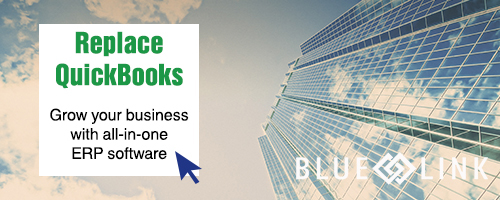All-in-one accounting and inventory software (also known as ERP) is designed to manage way more than just inventory and accounting. ERP software is designed to manage all aspects of a company’s operations and will provide benefits to employees in every department. That is one of the main benefits of switching to ERP: the system will streamlines business processes across your entire company. When specifically applied to wholesale distribution companies, this includes managing processes from order entry through to invoicing the customer, picking, packing and shipping product, and everything in between. For this reason, these types of systems are not comparable to introductory software such as QuickBooks, which focus only on one core area of the business such as accounting. ERP, on the other hand, is designed to replace introductory systems once a company reaches a certain level of growth. Although QuickBooks (and similar systems) are popular and widely used, trying to compare introductory software to Tier 2 or ERP software is like trying to compare a cell phone with a smartphone. Sure a cell phone can place calls and send texts and do those things really well, but a smartphone provides added features such as internet access and often replaces the need for having to perform tasks on a separate device (such as sending an email, checking your bank account or taking a picture). Many features that introductory systems lack - because of the nature of the software and target market - are inherent features of ERP. These include custom reporting capabilities, automation across functions such as sales orders and purchase orders, and robust inventory management. Proper accounting and inventory ERP software allows users to work from within the same system, on the same database, across departments. Here are some examples of the benefits that can be gained by each department:
The Accounting Department:
- Report writing tools to create custom reports in order to share visual data with investors/stakeholders
- Compliance tools to proactively maintain accounting standards and keep balanced books
- Automatic reminders and notifications that can be emailed (internally or to customers) to notify people of overdue accounts, sales history, etc.
- Features for managing A/R and A/P
The Warehouse Department and Purchasing:
- Barcode scanning features for easier picking, packing and shipping
- Integration with accounting system so order confirmation information is automatically sent to the accounting department
- Integration with shipping providers for order processing and shipping
- Ability to generate purchase orders directly from a sales order and then automatically allocate the inventory when received
- Tools for managing reorder levels and preferred suppliers based on pricing, lead times and sales history
The Sales Team:
- Ability to enter orders remotely through an online order portal integrated with the back-end accounting and inventory system in real-time
- Mobile tools for order entry and checking available inventory while on-site with customers and at trade shows
- CRM features for tracking communication with customers and leads
- Sales history review
- Reporting features for gathering information for marketing purposes such as top performing products, customers and geographic areas
- Order entry features to easily convert quotes to sales order to purchase orders
The IT Team:
- Decreased workload surrounding hardware and infrastructure maintenance and management with hosted/cloud solutions
- API tools for eCommerce integration – ability to transfer sales and product/inventory information from website to ERP system and vice versa
- EDI for automated data translation and transfer
- Encrypted database for secure storage of sensitive information and credit card processing
The Management Team:
- Reporting and forecasting tools based on past data for future predictions
- Ability to easily access information from the software to create meaningful reports for quicker decision making
- Permissions – ability to restrict user access in the system and monitor performance
Although the above examples are just a few of the many ways an all-in-one system can benefit employees across an organization, they should provide you with a better understanding of the differences between ERP and introductory systems. Depending on the company and processes, certain departments may overlap and employees may hold several roles, which makes an integrated solution that much easier to manage.











